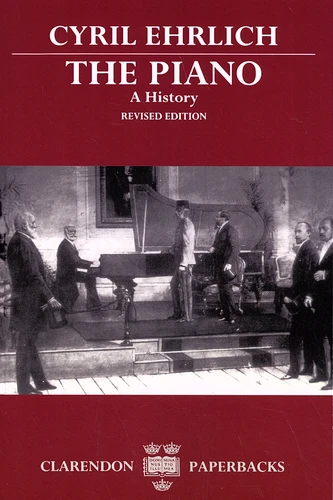The Piano. A History
Par :Formats :
- Paiement en ligne :
- Livraison à domicile ou en point Mondial Relay indisponible
- Retrait Click and Collect en magasin gratuit
- Réservation en ligne avec paiement en magasin :
- Indisponible pour réserver et payer en magasin
- Nombre de pages254
- PrésentationBroché
- FormatGrand Format
- Poids0.425 kg
- Dimensions15,5 cm × 23,5 cm × 1,5 cm
- ISBN0-19-816171-9
- EAN9780198161714
- Date de parution01/05/1990
- ÉditeurClarendon Press
Résumé
For more than a century the piano occupied a dominant place in music and society. The most versatile of instruments, it was also a chief focus of domestic entertainment and musical education and, not least, a coveted possession which symbolized social emulation and achievement. Based on exhaustive research in international archives this definitive and highly acclaimed history of the piano examines its technical and musical background, dealing at the same time with its social and economic importance-including the role designated for it by the Victorians of 'household orchestra and god' and 'highly respectableising instrument'.
Professor Ehrlich traces fascinating links between music, technology, business and society, ranging from forte-pianos to pianolas, Mozart to ragtime and International Exhibitions to the Australian outback. His protagonists include barnstorming virtuosi, fashionable ladies and aspiring clerks, the great makers and the back-street 'garret-masters', distinguished musicians and hire-purchase touts. He explains the revolution in industry and commerce which enabled pianos, once luxury goods, to be mass produced and which allowed the leadership of the industry to pass from England and France to America and Germany.
The final chapter describes the rise of Japanese manufacture-much earlier than is generally appreciated. Originally published in 1976 by J. M. Dent, this book has now been updated and revised by the author in the light of developments of recent years.
Professor Ehrlich traces fascinating links between music, technology, business and society, ranging from forte-pianos to pianolas, Mozart to ragtime and International Exhibitions to the Australian outback. His protagonists include barnstorming virtuosi, fashionable ladies and aspiring clerks, the great makers and the back-street 'garret-masters', distinguished musicians and hire-purchase touts. He explains the revolution in industry and commerce which enabled pianos, once luxury goods, to be mass produced and which allowed the leadership of the industry to pass from England and France to America and Germany.
The final chapter describes the rise of Japanese manufacture-much earlier than is generally appreciated. Originally published in 1976 by J. M. Dent, this book has now been updated and revised by the author in the light of developments of recent years.
For more than a century the piano occupied a dominant place in music and society. The most versatile of instruments, it was also a chief focus of domestic entertainment and musical education and, not least, a coveted possession which symbolized social emulation and achievement. Based on exhaustive research in international archives this definitive and highly acclaimed history of the piano examines its technical and musical background, dealing at the same time with its social and economic importance-including the role designated for it by the Victorians of 'household orchestra and god' and 'highly respectableising instrument'.
Professor Ehrlich traces fascinating links between music, technology, business and society, ranging from forte-pianos to pianolas, Mozart to ragtime and International Exhibitions to the Australian outback. His protagonists include barnstorming virtuosi, fashionable ladies and aspiring clerks, the great makers and the back-street 'garret-masters', distinguished musicians and hire-purchase touts. He explains the revolution in industry and commerce which enabled pianos, once luxury goods, to be mass produced and which allowed the leadership of the industry to pass from England and France to America and Germany.
The final chapter describes the rise of Japanese manufacture-much earlier than is generally appreciated. Originally published in 1976 by J. M. Dent, this book has now been updated and revised by the author in the light of developments of recent years.
Professor Ehrlich traces fascinating links between music, technology, business and society, ranging from forte-pianos to pianolas, Mozart to ragtime and International Exhibitions to the Australian outback. His protagonists include barnstorming virtuosi, fashionable ladies and aspiring clerks, the great makers and the back-street 'garret-masters', distinguished musicians and hire-purchase touts. He explains the revolution in industry and commerce which enabled pianos, once luxury goods, to be mass produced and which allowed the leadership of the industry to pass from England and France to America and Germany.
The final chapter describes the rise of Japanese manufacture-much earlier than is generally appreciated. Originally published in 1976 by J. M. Dent, this book has now been updated and revised by the author in the light of developments of recent years.


